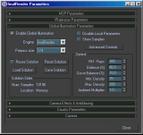|
|
 |
|
finalRender 101: Simple Environment and Object Based GI Added on: Mon Nov 26 2001 |
| Page: 1 2 3 |
 Go to the Material Editor and create three FinalRender materials, two for the spheres and one for the walls. Go to the Material Editor and create three FinalRender materials, two for the spheres and one for the walls.
Under the Caustics and Global Illumination rollout, turn off caustics and make sure both send and recieve are checked under Global illumination. Leave the settings at their default of 1. Apply them to your objects.
By now you've noticed that your shaded viewports are blacked out. In order to see your shaded viewport you need to temporarily turn on your omni or create another. Don't forget to turn it back off before rendering.
For at least one of the spheres set a specular and glossiness level similar to mine.

Open the Environment Dialogue and set the background color to pure white.

Right click any viewport and select Final Render Globals from the quad menu. Open the Global Illumination Parameters dialogue and enable GI.
For test renders keep the prepass size at the default level of 1/4. And for test renders the RH-Rays should usually be considerably lower lower than the 300 rays I'm using here, but this is a simple, low-poly scene and render times should be fairly painless.
Go ahead and render the scene.
|
 |
|
|




